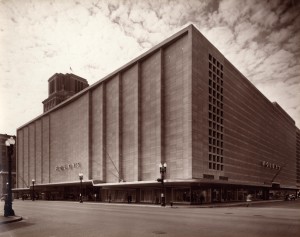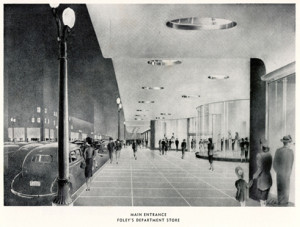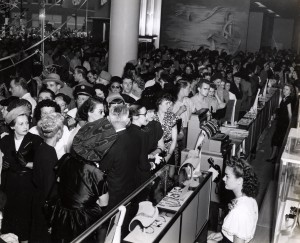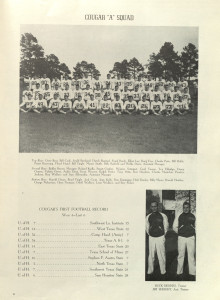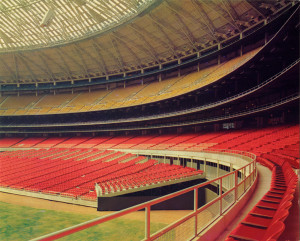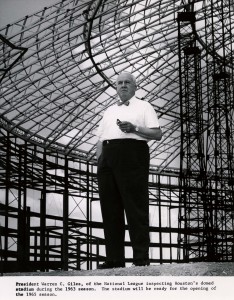
The following continues a series of contributions from Dr. Stephen James, who works with the Architecture and Planning collections here at the University of Houston Special Collections. Dr. James holds a Ph.D. in Architectural History from the University of Virginia and for many years was a lecturer at the University of Houston College of Architecture.
A part of Houston’s history disappeared last weekend. In the early morning hours of Sunday, September 22nd, demolition crews imploded the Macy’s building on Main Street in the downtown area. The building—until 2006 the flagship of the Foley’s department store chain—had not been an important part of Houston commerce and culture for many years. But its passing is another marker that requires us to look back, if only for a moment, at a time when Houston was a very different place than it is now.
The building’s grand opening in 1947 was a major event. With a population under 500,000, Houston was a much smaller city, and most people lived within a few miles of the downtown business district. There were no suburban shopping malls, and downtown was the focus for most shopping and entertainment. Citizens marveled at the new Foley’s building and welcomed the convenience of a large department store. Unlike smaller specialty retailers, Foley’s offered appliances, clothing, furniture, and many other items, all in one place. And what a place it was! With six floors of merchandise (later expanded to ten) covering an entire city block, it was enormous—a Texas-sized store for the state’s largest city. In keeping with the company’s ambitions to be the state’s premier retailer, Foley’s hired Kenneth Franzheim, one of the city’s leading architects, to design the new building. Air conditioning cooled the store’s shoppers while the fastest escalators sped them between floors.
In hindsight, Foley’s downtown store opened near the end of the era that spawned it. Less than a decade later, Houston began its explosive march to the suburbs. By the mid-1950s the opening of the city’s first automobile expressway, the Gulf Freeway, paved the way for Gulfgate, its first large suburban shopping mall. Others soon followed. And while the downtown store remained the flagship of a sprawling chain that catered to suburban shoppers, business dwindled downtown, as office workers and inner-city residents claimed the aisles.
Sadly, when the explosive charges brought down Franzheim’s massive store, the building had long outlived the business and social models that created it. The compact urban area focused on downtown was a quaint relic of an earlier day. It was time to move on in a city unable to embrace the future without first erasing its past.
The University of Houston preserves the history of the Foley’s building and the company that created it in the Foley’s Department Store Records, housed in Anderson Library’s Special Collections Department. The university’s William R. Jenkins Architecture and Art Library holds the Kenneth Franzheim Collection, which contains many of the architect’s drawings and papers. See also an earlier entry by Gregory Yerke in the Special Collections blog, “Foley’s and Houston: A Century of History”. For further information, researchers should consult Foley’s by Lasker M. Meyer (Charleston, S.C.: Arcadia Publishing, 2011).
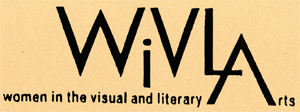 A juried show by the Women in the Literary and Visual Arts (WiVLA) will hold its opening reception at 6pm this evening at the Museum of Printing History. “Freeing The Word In Small Spaces” will showcase the work of artists challenged to reflect on and consider the possibilities of the evolution of the written word from hand-bound rarities, through the new accessibility afforded by the printing press, and on into a new paradigm that sees the printed word melding with the electronic device.
A juried show by the Women in the Literary and Visual Arts (WiVLA) will hold its opening reception at 6pm this evening at the Museum of Printing History. “Freeing The Word In Small Spaces” will showcase the work of artists challenged to reflect on and consider the possibilities of the evolution of the written word from hand-bound rarities, through the new accessibility afforded by the printing press, and on into a new paradigm that sees the printed word melding with the electronic device.
The Women in the Literary and Visual Arts was founded in the early 1990s in an ambitious attempt to create a network for writers and visual artists. The brainchild of a writer, an artist, and an art consultant, the early founders were members of a professional buisnesswomen’s organization and the benefits of a similar network for those in the creative community became readily apparent. The idea quickly gained traction and continues to provide a forum for women in Houston to nurture the creative efforts of others, collaborate artistically, and promote the work of members. Tonight’s opening reception marks another success in that journey.
Here at the University of Houston Special Collections, we are proud to make available for study the Women in the Visual and Literary Arts Records. Though relatively young in its history, the WiVLA Records provide a look at their formation, organization, and work supporting artists through the years. Materials in the collection include not only administrative documents and communications, but also information and photographs documenting events and shows through the years.
If you have not already, make plans to attend “Freeing The Word In Small Spaces.” While you are at it, why not come see what WiVLA’s history holds as well?
A small bit of history was made this past weekend in Philadelphia, as the final seconds ticked off the clock and our University of Houston Cougars celebrated a victory over the Temple University Owls in the inaugural game of the new American Athletic Conference.
The last few decades and, more recently, the last few years have sent fans of collegiate athletics scrambling to make sense of changing conference landscapes. The Houston Cougar football teams have a varied and winding history of conference affiliation that can be traced through many resources available here in Special Collections and via our Digital Library. A look through the Athletics Department Records in the University Archives or a virtual stroll through the old Houstonian yearbooks provide some perspective for an evolution that continues today and helps trace the history of collegiate athletic conferences in Texas, the Southwest, and beyond.
1946 – 1948 – Lone Star Conference:
The Houston Cougars football program was born in 1946, during a renaissance of collegiate athletics as an influx of veterans from World War II made their way onto campuses. At the University of Houston, the Veterans Village, housing veterans and their families, became a symbol of that new growth. These brand new Cougars played in the Lone Star Conference through 1948, competing against conference mates such as North Texas and Sam Houston State.
1949 – 1950 – Gulf Coast Conference:
After getting their feet wet in collegiate athletics, the University of Houston decided to branch out and helped form the short-lived, now-defunct Gulf Coast Conference alongside other charter members Midwestern State, Trinity University, and the aforementioned North Texas.
1951 – 1959 – Missouri Valley Conference:
The Gulf Coast Conference experiment did not last long for the Coogs and an invite to the Missouri Valley Conference was accepted where, starting in 1951, just five years after the team’s formation, the Cougars were already playing in their third conference. There they formed rivalries with Oklahoma State, University of Tulsa, and others.
1960 – 1975 – Major Independent:
Throughout these early years, flirtations persisted with the more prestigious Southeastern and Southwest Conferences, but these ultimately came to naught. After winning four Missouri Valley Conference titles in nine years of play, the Cougars struck out on their own again. This time they competed as a major independent football power from 1960 through the 1975 season, challenging and defeating some of the nation’s top programs and finding themselves nationally ranked, more often than not. Much of this success was due to the iconic, inventive, and legendary Bill Yeoman, head coach of the Cougars from 1962 to 1986. This new era of success did not go unnoticed by the in-state neighbors.
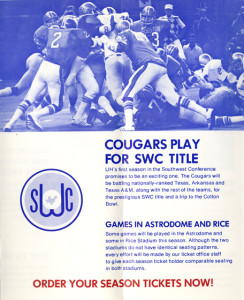
promotional material for the 1976 football season, from the Athletic Department Records, UH Special Collections
1976 – 1995 – Southwest Conference:
The long-awaited invitation from the Southwest Conference finally came for the 1976 season. The Cougars made up for lost time, besting the other major programs of the state (as well as the University of Arkansas), winning the SWC title three of the first four years in their new home, including the inaugural 1976 season that saw the Coogs finish with 10 wins, 2 losses, and ranked in the top 5 nationally. Conference affiliations and stability would be short-lived, however, as only two decades time would see the end of an era with the collapse of the conference in 1995, spurred on by the earlier loss of the University of Arkansas and the defection of the University of Texas, Texas A&M University, Texas Tech University, and Baylor University to the newly restructured Big XII Conference (note: For those further interested in studying the long-standing SWC institution, our colleagues at Texas Tech University continue to do a fine a job of making almost 100 years of intercollegiate athletic history available for study via the Southwest Athletic Conference Records).
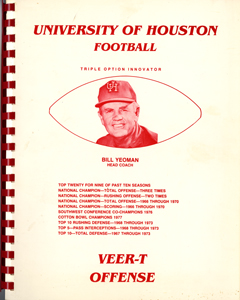
cover of Bill Yeoman’s Veer-T Playbook, available for viewing in the University of Houston Special Collections Reading Room
1996 – 2012 – Conference USA:
Again, the University of Houston forged their own path and became integral in the merger of the Metro and Great Midwest Conferences to form the new Conference USA where they would go on to compete against some new and old friends alike from 1996 through the 2012 season. It was during this era that the Cougars moved back onto campus, playing in a renovated Robertson Stadium.
The Present and the Future – American Athletic Conference:
Demolition has effaced “The Rob” from campus maps and new construction has fans and alumni optimistic for the future. A quick glance at the past or a look at the present headlines regarding collegiate athletics assures us that the only certainty is, nothing is certain.
Except this.
It is certain that autumn Saturdays will continue to see a handful of student-athletes fight for the red and white and dear old U of H.
And, it is certain, a remarkably diverse and unified nation of Cougar faithful will be there cheering them on in Philadelphia, Houston, and anywhere else the future takes them.
Today the National Trust for Historic Preservation released its 26th annual list of America’s 11 Most Endangered Places, and guess who made the list.
For Astrodome preservationists, the announcement comes not a moment too soon.
Just a few months ago NFL Commissioner Roger Goodell started rattling the wrecking balls, suggesting it would enhance Houston’s chances of hosting the 2017 Super Bowl should the Astrodome be demolished noting, “Whether it’s more parking, whether we can have more events there on that space — it’s not just the stadium itself, it’s the area surrounding it that’s valuable. And, I think that could be a very positive change in their Super Bowl bid.” (Footnote: Houston was later awarded the bid with no definite word on the future of the Dome.)
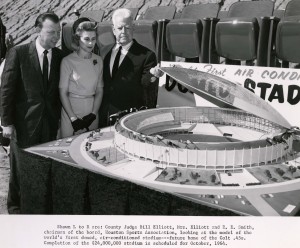 So, naturally, the threat of the Dome’s demise has many waxing nostalgic, including yours truly, and finds me digging through the George Kirksey Papers. Kirksey, along with Roy Hofheinz and others, was instrumental in bringing Major League Baseball to Houston. The scope of his papers, held here at the University of Houston Special Collections, extends beyond baseball, but they do contain some real photographic gems from the Dome’s design, groundbreaking, and through its golden era (some included here).
So, naturally, the threat of the Dome’s demise has many waxing nostalgic, including yours truly, and finds me digging through the George Kirksey Papers. Kirksey, along with Roy Hofheinz and others, was instrumental in bringing Major League Baseball to Houston. The scope of his papers, held here at the University of Houston Special Collections, extends beyond baseball, but they do contain some real photographic gems from the Dome’s design, groundbreaking, and through its golden era (some included here).
Goodell was right about the Astrodome and the land it is on being valuable. It is just that not everything can be calculated via a return-on-investment spreadsheet, and the true value of the Astrodome, standing in some form or another, is beyond mere value as we understand it these days in Houston.
Reading the tea leaves of the Dome’s future is an exercise in futility and frustration. However, it is encouraging to see Mayor Parker express interest in preservation ideas akin to the master’s project of UH’s own Ryan Slattery, but the future of the Dome is still in doubt.
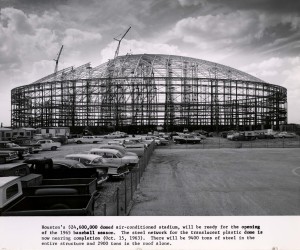 Whatever becomes of it, there is not much that can be said here that has not already been captured by a number of impassioned pleas, linking Houston’s sporting history to that of the Astrodome’s timeline. However, for those who are not sports fans or who did not make memories in this grand experiment of a stadium, let us set aside the history of the Astros, the Oilers, the Houston Livestock Show and Rodeo, the Game of the Century, the Battle of the Sexes, et al. The Astrodome speaks to something larger.
Whatever becomes of it, there is not much that can be said here that has not already been captured by a number of impassioned pleas, linking Houston’s sporting history to that of the Astrodome’s timeline. However, for those who are not sports fans or who did not make memories in this grand experiment of a stadium, let us set aside the history of the Astros, the Oilers, the Houston Livestock Show and Rodeo, the Game of the Century, the Battle of the Sexes, et al. The Astrodome speaks to something larger.
That this audacious figment of our collective imagination (No mosquitoes? Air-conditioned baseball in Houston?!) could be brought into being, transcends the idea or concept of a niche sporting audience and speaks to us not solely in terms of sport. It speaks, perhaps, more in terms of our ingenuity, our desire to always overcome and produce that which seems futile or silly and, admittedly, to do so in ways that may see the execution of it all fall short of our lofty, futuristic visions.
So, there it was built and there it stands, as a monument to all that is comical and wonderful and, yes, endearing about us. It remains a symbol of our moonshot in an era where the Moon seemed suddenly within reach.
Driving by the Astrodome at night, even dwarfed as it is by the sterile Reliant Stadium, it seems to grumble, “We are the masters of our domain. We will control the environment on a massive scale, and we will restore novelty to the novel, creating a spectacle of sport again. We will always figure out how to manifest our yearning in ways that are bigger and infinitely more ingenious, for better or for worse.”
A little hubris, there? Perhaps. But, then, all the more reason to retain it as a reminder. Either as an albatross or our Eiffel, the Dome should stand.
The work of professor and scholar Michael A. Olivas, of the UH Law Center, will now be translated into a gift of philanthropy, scholarship, and conscience.
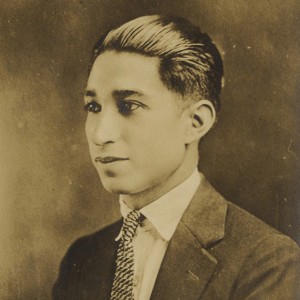
Alonso S. Perales (aged 17, 1915), available for high resolution download at our Digital Library here
This month, Arte Público Press publishes In Defense of My People edited by Professor Olivas. The book assembles a collection of essays from Mexican and U.S. scholars on the life and legacy of Alonso S. Perales, initially presented as part of a 2012 conference and exhibit organized in conjunction with the University of Houston Special Collections and the U.S. Hispanic Literary Heritage Project. Alonso S. Perales was noted for his civil rights legal work in the Mexican-American community as well as his influential and prolific writing on the topic of racial equality. However, he is perhaps most remembered for the leadership he was able to provide in maneuvering the legal and logistical hurdles of uniting a number of disparate civil rights organizations under the banner of LULAC.
(Professor Olivas provides some background and perspective on Alonso S. Perales)
Arte Público Press and Olivas will donate royalties from purchases of the book to establish a scholarship with the UH Law Center’s Hispanic Law Student Association. The first scheduled award, to a recipient exhibiting “academic merit and a record of involvement in the Houston Latino community,” is slated for 2014.
Thanks to the generous donation of the Perales family, the Alonso S. Perales Papers are now more accessible to the community at large and we are pleased to have them available for study in the Special Collections reading room during normal reference hours. This collection, a part of our larger Hispanic Collections, is a rich resource and draw for scholars still attempting to provide a robust picture of a region and time complicated by competing ambitions and voices. For starters, the collection includes correspondence with other noted civil rights leaders, organizational documents for LULAC, as well as his notes regarding personal writings, interviews, and radio addresses. However, the detailed finding aid will be able to guide your research and provide more insight into the contents.
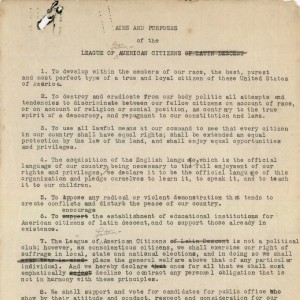
“League of Latin American Citizens – Aims and Purposes,” from our Digital Library, available for high resolution download here
Our Digital Library has assembled a number of documents and photographs as highlights from this collection and they are available for viewing and high resolution download here. In addition to the Perales papers, our Hispanic Collections offer a number of finding aid resources that may complement your study.
The history of “Aztlán” is infinitely complex and made more so when voices are muted. We are pleased that, thanks to the efforts of scholars like Professor Olivas and others, those voices continue to garner an audience. In addition, thanks to the continued generosity of he and his wife, Professor Augustina Reyes, now another scholarship has been established to ensure those futures voices are heard.
Please take a look at some of the online resources above. If you are just beginning your education on Perales and his impact, videos from scholars on the exhibit page should provide a nice introduction. However, if you are looking to expand your research, come visit us at your earliest convenience.
